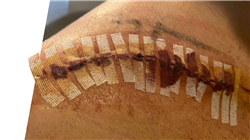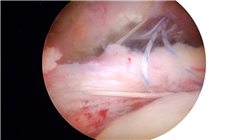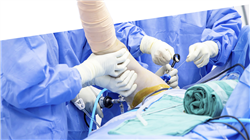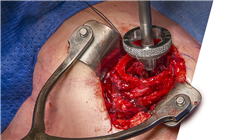University certificate
The world's largest faculty of medicine”
Description
You will delve into the most important advances in Shoulder Surgery , keeping you with TECH at the forefront of this specialty"

Due to the high incidence of shoulder injuries, especially in the rotator cuff, and their impact on the quality of life of those affected, minimally invasive procedures, surgical techniques and prostheses have been improved in recent years. These advances are accompanied by a constant updating of specialists interested in integrating the most notable advances into their practice.
In this sense, TECH has developed this program, which will allow the professional to have an update on the latest diagnostic advances, as well as therapeutic procedures applied in Shoulder Surgery .
Throughout 12 months of intensive updating, the doctor will explore in depth the different access routes to be used for open surgery, the different arthroscopic entrances and the applied anatomy. In addition, it will delve into the main indications for various radiological techniques such as conventional radiography, computed tomography and arthroCT. To do so, you will have a wide variety of multimedia resources or clinical case studies that will show you various situations you might encounter in your daily practice.
Following this approach, the program is presented in a 100% online format, which will provide the graduate with the possibility to reconcile his or her daily activities with those of updating his or her knowledge. In addition, this methodology combined with the Relearning method will allow you to deepen your knowledge by remembering the most relevant concepts in less time and without investing long hours of study.
With TECH, you will delve into the key points of Shoulder Surgery and improve your surgical skills in this highly specialized area"
This Professional master’s degree in Shoulder Surgery contains the most complete and up-to-date scientific program on the market. The most important features include:
- The development of case studies presented by expert orthopedic surgeons
- The graphic, schematic, and practical contents with which they are created, provide scientific and practical information on the disciplines that are essential for professional practice
- Practical exercises where self-assessment can be used to improve learning
- Its special emphasis on innovative methodologies
- Theoretical lessons, questions to the expert, debate forums on controversial topics, and individual reflection assignments
- Content that is accessible from any fixed or portable device with an Internet connection
In just 12 months you will explore in detail the osteology of the shoulder and update the knowledge necessary to perform successful implants”
The program’s teaching staff includes professionals from sector who contribute their work experience to this educational program, as well as renowned specialists from leading societies and prestigious universities.
Its multimedia content, developed with the latest educational technology, will provide the professional with situated and contextual learning, i.e., a simulated environment that will provide an immersive education programmed to learn in real situations.
The design of this program focuses on Problem-Based Learning, by means of which the professional must try to solve the different professional practice situations that are presented throughout the academic course. For this purpose, the student will be assisted by an innovative interactive video system created by renowned experts.
With this Professional master’s degree program you will learn about arthrology and the ligaments of the shoulder, expanding your clinical skills"

He implements the different techniques of shoulder approach and acquires skills in minimally invasive procedures"
Syllabus
The agenda of this program encompasses a wide variety of relevant concepts related to Shoulder Surgery . In this way, the specialist will be kept up to date on the latest advances in radiography, tomography and magnetic resonance techniques. He will also delve into the phylogeny of the shoulder and the rheumatic diseases that affect it. In addition, content will be available to physicians in multimedia formats, such as interactive summaries and simulations of real cases. In addition, physicians will be able to access this content 100% online, without having to adhere to specific schedules.

Through the Relearning method you will experience a decrease in study hours and strengthen your long-term understanding significantly”
Module 1. Arthroscopic Approach to the Scapular Belt
1.1. Shoulder Surgery
1.1.1. Shoulder Surgery
1.1.2. Shoulder Surgery Milestones
1.1.3. Key points of Shoulder Surgery
1.2. Shoulder Osteology
1.2.1. The Humerus. Osteology relevant to Shoulder Surgery
1.2.2. The Scapula. Osteology relevant to the realization of scapula implants
1.2.3. The collarbone
1.3. Glenohumeral joint: arthrology, capsule and ligaments
1.3.1. Glenohumeral Joint Arthrology
1.3.2. Joint Structures Relevant to Shoulder Surgery Treatment
1.3.3. Capsule of the Glenohumeral Joint, clinical relevance
1.3.4. Ligaments of the Glenohumeral Joint, clinical relevance
1.4. Acromioclavicular, sternoclavicular and scapulothoracic joints
1.4.1. Acromioclavicular joint: Relevant Structures for Surgical Treatment
1.4.2. Sternoclavicular joint
1.4.3. Scapulothoracic joint: Relevant aspects in the diagnosis and treatment of the pathology
1.5. Muscles of the shoulder girdle
1.5.1. Glenohumeral muscles
1.5.2. Scapulothoracic Muscles
1.5.3. Muscles involved in various joints
1.5.4. Landmark Muscles
1.6. Innervation and vascularization of the shoulder
1.6.1. Relation of Shoulder Innervation and Vascularization to Arthroscopic Approaches and Portals
1.6.2. Shoulder innervation
1.6.3. Shoulder Vascularization
1.7. Shoulder Biomechanics
1.7.1. Relation of Shoulder Biomechanics to Current Surgical Techniques
1.7.2. Advanced Shoulder Biomechanics
1.7.3. Physiology of Shoulder Movements
1.8. Shoulder approach routes
1.8.1. Relevant Structures for Shoulder Surgical Approaches
1.8.2. Shoulder approach routes
1.8.3. Minimally invasive approaches to the Shoulder
1.9. Shoulder arthroscopy. Arthroscopic portals and applied anatomy
1.9.1. Shoulder Arthroscopy
1.9.2. Arthroscopic portals
1.9.3. Applied Anatomy in Shoulder Arthroscopy
1.10. New technologies applied to Shoulder Surgery
1.10.1. 3D printing of bone structures
1.10.2. Surgical planning platforms
1.10.3. Custom-made implants
1.10.4. Shoulder Surgery Navigation
Module 2. Radiology, other diagnostic techniques and scales
2.1. Radiography in the Diagnosis of Shoulder Pathology
2.1.1. Radiography as an initial study in shoulder pathology
2.1.2. Indication of radiography in pathology of the shoulder
2.1.3. Radiographic projections of the shoulder
2.2. Computed Axial Tomography (CT) and ArthroTAC in the Diagnosis of Shoulder Pathology
2.2.1. CT and arthroCT
2.2.2. CT in Shoulder Pathology
2.2.3. ArthroTAC in the pathology of the shoulder
2.3. Magnetic Resonance Imaging (MRI) in Shoulder Pathology
2.3.1. Magnetic Resonance Imaging (MRI) for the study of the shoulder
2.3.2. MRI in traumatic shoulder pathology
2.3.3. MRI in non-traumatic shoulder pathology
2.4. ArthroMRI in Shoulder Pathology
2.4.1. ArthroMRI in Shoulder Pathology
2.4.2. ArthroRMN in Shoulder Instability
2.4.3. ArthroRMN in rotator cuff tears
2.5. Diagnosis by ultrasound. Eco-guided Techniques
2.5.1. Ultrasound. Principles of Ultrasound Study of the Shoulder
2.5.2. Ultrasound in the pathology of the shoulder
2.5.3. Ultrasound-guided techniques in shoulder pathology
2.6. Nuclear Medicine in Shoulder Pathology
2.6.1. Important Aspects
2.6.1.1. Planar Gammagraphic and SPTECT CT images
2.6.1.2. PET-CT
2.6.2. Conventional Nuclear Medicine in Infectious Pathology
2.6.2.1. Bone scan
2.6.2.2. Labeled leukocyte scintigraphy and bone marrow scintigraphy
2.6.3. Clinical PET-CT Applications
2.7. Neurophysiology
2.7.1. Neurophysiology
2.7.2. Neurophysiology in the Locomotor System
2.7.3. Neurophysiological diagnosis of the most frequent injuries of the shoulder girdle
2.8. Objective Scales in Shoulder Pathology
2.8.1. Objective scale
2.8.2. Objective scales in Shoulder Pathology
2.8.3. Applications of objective scales in shoulder pathology
2.9. Subjective Scales in Shoulder Pathology
2.9.1. Subjective scale
2.9.2. Objective scales in Shoulder Pathology
2.9.3. Applications of subjective scales in shoulder pathology
2.10. Quality of life scales. Applications in Shoulder Pathology
2.10.1. Quality of life scale
2.10.2. Quality of life scales in shoulder pathology
2.10.3. Applications of quality of life scales in shoulder pathology
Module 3. Congenital, pediatric and rheumatic pathologies, infections and tumors. Anesthesia
3.1. Phylogeny, Embryology and Ossification of the Shoulder
3.1.1. Phylogeny of the Shoulder
3.1.2. Shoulder Embryology
3.1.3. Shoulder Ossification
3.2. Dysplasias affecting the shoulder
3.2.1. Congenital Shoulder Pathology
3.2.2. Dysplasias and syndromes involving the shoulder girdle
3.2.3. Orthopedic and surgical management
3.3. Obstetric Brachial Palsy
3.3.1. Types of obstetric brachial palsy
3.3.2. Clinical Manifestations and Differential Diagnosis
3.3.3. Treatment
3.3.4. Residual deformities and management
3.4. Fractures of the proximal humerus, clavicle, scapula and acromioclavicular joint injuries in children
3.4.1. Shoulder fractures in children
3.4.2. Shoulder dislocations in children
3.4.3. Other Acquired Shoulder Problems in Children
3.5. Metabolic bone pathology. Diseases due to altered osteoclastic function. Neurofibromatosis. Collagen and soft-tissue disorders
3.5.1. Metabolic bone pathology
3.5.2. Diseases due to alteration of osteoclastic function
3.5.3. Neurofibromatosis
3.5.4. Collagen and soft-tissue disorders
3.6. Rheumatic diseases affecting the Shoulder
3.6.1. Rheumatic diseases affecting the shoulder girdle
3.6.2. Diagnosis of rheumatic diseases affecting the shoulder
3.6.3. Therapeutic algorithm and aspects to be taken into account in the surgical treatment of rheumatic patients
3.7. Shoulder Infections
3.7.1. Anamnesis and Physical Examination
3.7.2. Etiopathogenesis
3.7.3. Diagnosis of Shoulder Infections
3.7.4. Medical and surgical treatment. Therapeutic Algorithms
3.8. Common tumors affecting the shoulder girdle
3.8.1. Most common shoulder tumors
3.8.2. Algorithm for an adequate diagnosis
3.8.3. Therapeutic Algorithms
3.9. Anesthesia in procedures affecting the Shoulder
3.9.1. Regional Anesthesia
3.9.2. General Anesthesia
3.9.3. Brachial plexus block. Complications
3.9.4. Preoperative and Intraoperative Considerations
3.9.5. Postoperative Anesthesia Care
3.10. Treatment of pain in pathologies affecting the shoulder: Preoperative and postoperative
3.10.1. Techniques
3.10.2. Suprascapular nerve block and intra-articular nerve block
3.10.3. Radiofrequency and stimulation
3.10.4. Botulinum toxin
Module 4. Rotator Cuff (I). Subacromial Syndrome and Rotator Cuff Ruptures
4.1. Rotator cuff
4.1.1. The shoulder girdle
4.1.2. Rotator Cuff Muscles
4.1.3. Innervation of the Rotator Cuff Muscles
4.2. Rotator Cuff Disease
4.2.1. Rotator Cuff Disease
4.2.2. Evolutionary history of rotator cuff disease
4.2.3. Rotator Cuff Disease Treatment
4.3. Anamnesis and clinical examination. Maneuvers and diagnostic techniques
4.3.1. Anamnesis in Rotator Cuff Pathology
4.3.2. Exploratory maneuvers in rotator cuff pathology
4.3.3. Diagnostic techniques in Rotator Cuff Pathology
4.3.4. Rotator Cuff Rupture Classification
4.4. Subacromial syndrome without rotator cuff injury
4.4.1. Subacromial syndrome without rotator cuff injury
4.4.2. Diagnosis of subacromial syndrome without rotator cuff lesions
4.4.3. Treatment of subacromial syndrome without rotator cuff injury
4.5. Partial posterosuperior cruciate cuff ruptures
4.5.1. Diagnosis of partial rotator cuff tears
4.5.2. Surgical indication of partial ruptures of the Posterosuperior Cuff
4.5.3. Surgical techniques in partial Posterosuperior Posterior Cuff Injuries
4.6. Repairable complete posterosuperior posterosuperior cuff ruptures
4.6.1. Diagnosis of complete posterosuperior repairable breaks of the posterosuperior sleeve
4.6.2. Repairable complete ruptures of the posterosuperior cuff
4.6.3. Surgical techniques in repairable posterosuperior cuff ruptures
4.7. Subscapularis ruptures
4.7.1. Diagnosis of subscapularis ruptures
4.7.2. Classification of subscapularis tears
4.7.3. Subscapularis repair surgical techniques
4.7.4. Surgical approach to PLB pathology concomitant with anterosuperior cuff lesions
4.8. Massive repairable Rotator Cuff Ruptures
4.8.1. Diagnosis of massive repairable rotator cuff tears
4.8.2. Classification of massive repairable rotator cuff tears
4.8.3. Surgical techniques in massive repairable cuff ruptures
4.9. Irreparable Rotator Cuff Ruptures
4.9.1. Diagnosis of irreparable massive rotator cuff tears
4.9.2. Classification of irreparable massive rotator cuff ruptures
4.9.3. Surgical techniques for massive irreparable cuff tears
4.10. Therapeutic algorithm for rotator cuff tears
4.10.1. Therapeutic Algorithms
4.10.2. Therapeutic algorithm for rotator cuff tears
4.10.3. Usefulness of the therapeutic algorithm for rotator cuff tears
Module 5. Rotator cuff (II). Calcifying Tendinitis. Stiffness
5.1. Arthroscopic knotting techniques
5.1.1. Key terms and points in knot mechanics
5.1.2. Slip knots
5.1.3. Non-slip knots
5.1.4. Knot suture in Shoulder arthroscopy
5.2. Rehabilitation in cuff rupture: postoperative treatment: Immobilization and Physiotherapy
5.2.1. Indication and immobilization times according to tear pattern in postoperative treatment of rotator cuff tears
5.2.2. Indication of the different physiotherapy techniques in the postoperative period following rotator cuff rupture
5.2.3. Physiotherapy techniques for rotator cuff postoperative period
5.2.4. Postoperative treatment algorithm for rotator cuff tears
5.3. Rehabilitation in cuff rupture: Conservative treatment of rotator cuff tears. Indications and Techniques
5.3.1. Indication for conservative treatment with rehabilitation in rotator cuff tears
5.3.2. Physiotherapy techniques in conservative treatment of Rotator Cuff
5.3.3. Therapeutic algorithm in rehabilitation treatment in conservative treatment of rotator cuff tears
5.4. Complications of rotator cuff repair: Infections, Rebreaks, Stiffness
5.4.1. Complications of rotator cuff repair
5.4.2. Diagnosis of Rotator Cuff Rupture Complications
5.4.3. Therapeutic approach to the different rotator cuff complications
5.5. Calcifying tendinitis
5.5.1. Calcifying tendinitis
5.5.2. Anamnesis and Physical Examination
5.5.3. Diagnostic techniques in calcifying tendinitis
5.5.4. Therapeutic Algorithms
5.6. Stiff shoulder: diagnosis and types of stiffness. Rotator Cuff Ruptures and coexisting preoperative stiffness
5.6.1. Diagnosis of glenohumeral stiffness
5.6.2. Types of glenohumeral stiffness
5.6.3. Rotator cuff tears and coexisting stiffness. Diagnosis and Treatment
5.7. Adhesive capsulitis, definition and predisposing diseases, anamnesis, examination and prognosis. Evolution
5.7.1. Adhesive capsulitis
5.7.2. Predisposing diseases
5.7.3. Anamnesis and Physical Examination
5.8. Capsulitis: conservative vs. surgical treatment
5.8.1. Therapeutic Algorithms
5.8.2. Conservative treatment of adhesive capsulitis
5.8.3. Surgical treatment of adhesive capsulitis
5.9. Glenohumeral internal rotation deficit (GIRD)
5.9.1. Internal rotation deficit (GIRD)
5.9.2. Anamnesis and Physical Examination
5.9.3. Therapeutic Algorithms
5.10. Coexisting Rotator Cuff Breaking and Instability
5.10.1. Anamnesis and Physical Examination
5.10.2. Diagnosis
5.10.3. Therapeutic Algorithms
5.10.4. Treatment. Surgical Techniques
Module 6. Glenohumeral Instability
6.1. Lenohumeral joint. Arthroscopic and external view in open surgery
6.1.1. Glenohumeral Joint
6.1.2. Arthroscopic view of the Glenohumeral Joint
6.1.3. External view of the shoulder focused on open surgery techniques
6.2. Clinical Evaluation Exploratory maneuvers
6.2.1. Anamnesis in glenohumeral instability
6.2.2. Hyperlaxity: measurement and predisposing diseases
6.2.3. Exploratory maneuvers in glenohumeral instability
6.2.4. Diagnostic techniques in glenohumeral instability
6.3. Anterior instability: Conservative and surgical treatment. Measurement of bone deficit
6.3.1. Measurement of bone deficit
6.3.2. Indication of conservative and surgical treatment in anterior instability
6.3.3. Therapeutic algorithm in anterior instability
6.4. Anterior instability: soft tissue surgical techniques. Open and arthroscopic Bankart. Arthroscopic Remplissage
6.4.1. Soft tissue surgical techniques
6.4.2. Arthroscopic Bankart surgical technique
6.4.3. Arthroscopic Remplissage Surgical Technique
6.4.4. Open Bankart surgical technique
6.5. Anterior instability: surgical techniques with bone stop. Open and arthroscopic latarjet. Bony Bankart arthroscopic
6.5.1. Arthroscopic knotting techniques
6.5.2. Open Latarjet surgical technique
6.5.3. Bony Bankart arthroscopic technique
6.6. Posterior instability: Conservative and surgical treatment. Surgical Techniques
6.6.1. Anamnesis and Physical Examination
6.6.2. Conservative Treatment
6.6.3. Surgical Management
6.6.4. Therapeutic Algorithms
6.6.5. Surgical techniques in posterior instability
6.7. Multidirectional instability. Microinstability. Hyperlaxity. Sports Injuries Rehabilitation Treatment
6.7.1. Multidirectional instability, microinstability, and hyperlaxity
6.7.2. Multidirectional instability. Rehabilitative treatment
6.7.3. Glenohumeral microinstability. Rehabilitative treatment
6.8. Multidirectional instability. Microinstability. Hyperlaxity. Sports Injuries Surgical Management
6.8.1. Surgical Treatment Indications
6.8.2. Multidirectional instability. Surgical Management
6.8.3. Glenohumeral microinstability. Surgical Management
6.9. Complications and sequelae of glenohumeral instability
6.9.1. Complications of conservative treatment
6.9.2. Complications of surgical treatment
6.9.3. Sequels of glenohumeral instability: Conservative and surgical treatment
6.10. Rescue of instability surgery: Bone cap and final arthrodesis
6.10.1. Therapeutic algorithm for the rescue of instability surgery
6.10.2. Bone stop as Latarjet rescue technique
6.10.3. Arthrodesis as the last step
Module 7. Scapulothoracic. Neurological Injuries
7.1. Biomechanics of the scapula and scapulothoracic joint
7.1.1. Scapulothoracic joint
7.1.2. Biomechanics of the Scapular Waist
7.1.3. Biomechanics of the Scapulothoracic Joint
7.2. Abnormal scapulothoracic joint mobility
7.2.1. Normal scapulothoracic joint mobility
7.2.2. Diagnosis of abnormal scapulothoracic joint mobility
7.2.3. Treatment of Abnormal scapulothoracic joint mobilit
7.3. Pectoralis minor hyperactivation syndrome
7.3.1. Pectoralis minor hyperactivation syndrome
7.3.2. Diagnosis of pectoralis minor hyperactivation syndrome
7.3.3. Treatment of pectoralis minor hyperactivation syndrome
7.4. Serratus anterior palsy
7.4.1. Serratus anterior palsy
7.4.2. Diagnosis of serratus anterior paralysis
7.4.3. Treatment of serratus anterior palsy
7.5. Trapezius paralysis
7.5.1. Trapezius paralysis
7.5.2. Diagnosis of trapezius palsy. Diagnosis
7.5.3. Treatment of trapezius palsy
7.6. Axillary nerve neuropathy
7.6.1. Axillary nerve neuropathy
7.6.2. Diagnosis of axillary nerve neuropathy
7.6.3. Treatment for axillary nerve neuropathy
7.7. Suprascapular nerve neuropathy. Quadrilateral space syndrome
7.7.1. Suprascapular nerve neuropathy
7.7.2. Diagnosis of Suprascapular Nerve Neuropathy
7.7.3. Treatment of Suprascapular Nerve Neuropathy
7.7.4. Quadrilateral space syndrome
7.7.5. Diagnosis of Quadrilateral Space Syndrome
7.7.6. Treatment of Quadrilateral Space Syndrome
7.8. Scapulothoracic pathology associated with other processes
7.8.1. Acromioclavicular pathology
7.8.2. Sternoclavicular pathology
7.8.3. Glenohumeral Instability
7.8.4. Dysplasia
7.8.5. Brachial palsy
7.8.6. Others
7.9. Snapping scapula
7.9.1. Snapping scapula
7.9.2. Diagnosis of Snapping scapula
7.9.3. Snapping scapula treatment
7.10. Rehabilitative treatment of scapulothoracic dysfunction
7.10.1. Scapulothoracic Dysfunction
7.10.2. Diagnosis of Scapulothoracic Dysfunction. Diagnosis
7.10.3. Rehabilitative treatment of scapulothoracic dysfunction
Module 8. Acromioclavicular, sternoclavicular and long portion of biceps joints
8.1. Acromioclavicular joint and sternoclavicular joint. Sternoclavicular joint pathology
8.1.1. The acromioclavicular joint
8.1.2. The sternoclavicular joint
8.1.3. Sternoclavicular joint pathology
8.2. Acute acromioclavicular dislocation. Conservative Treatment
8.2.1. Acute acromioclavicular dislocation
8.2.2. Diagnosis of Acute Acromioclavicular Dislocation
8.2.3. Conservative treatment of the acute acromioclavicular joint
8.2.4. Surgical treatment of the acute acromioclavicular joint
8.3. Surgical treatment and surgical techniques for acute acromioclavicular dislocation
8.3.1. Acute acromioclavicular dislocation
8.3.2. Surgical treatment for acute acromioclavicular dislocation
8.3.3. Acute acromioclavicular dislocation surgical techniques
8.4. Chronic acromioclavicular dislocation. Surgical treatment techniques
8.4.1. Chronic acromioclavicular dislocation
8.4.2. Surgical Management
8.4.3. Surgical treatment techniques
8.5. Complications of acromioclavicular dislocation associated with conservative and surgical treatment
8.5.1. Complications of acute acromioclavicular dislocation treated conservatively
8.5.2. Complications of acute acromioclavicular dislocation treated surgically
8.5.3. Complications of chronic acromioclavicular dislocation treated conservatively
8.5.4. Complications of chronic acromioclavicular dislocation treated surgicall
8.6. Long portion of the biceps: Anatomical Variants
8.6.1. The shoulder girdle
8.6.2. The long portion of the biceps
8.6.3. Anatomical variants of the long portion of the biceps
8.7. Long portion of the biceps: SLAP lesions
8.7.1. SLAP lesions
8.7.2. Classification of SLAP Lesions
8.7.3. Conservative Treatment
8.7.4. Surgical Management
8.8. Long portion of the biceps: surgical treatment techniques
8.8.1. The long portion of the biceps
8.8.2. SLAP lesions: surgical treatment techniques
8.8.3. Complications of the surgical treatment of SLAP lesions
8.9. Isolated lesions of the long portion of the biceps: tenosynovitis, instability and partial ruptures
8.9.1. Tenosynovitis
8.9.2. Instability
8.9.3. Partial ruptures
8.10. Tenotomy versus tenodesis of the long portion of the biceps
8.10.1. Indications for biceps longus tenotomy
8.10.2. Indications for biceps longus tenodesis
8.10.3. Tenotomy versus tenodesis
Module 9. Scapular Waist Fractures
9.1. Proximal Humerus Fractures: Conservative Treatment
9.1.1. Proximal Humerus Fractures
9.1.2. Indications for conservative treatment
9.1.3. Conservative treatment of proximal humerus fractures
9.2. Proximal Humerus Fracture: Surgical Treatment. Osteosynthesisç
9.2.1. Indications for surgical treatment by Osteosynthesis
9.2.2. Locked Proximal Humerus PCL Plate: indications and surgical technique
9.2.3. Endomedullary nailing: indications and surgical technique
9.2.4. Other osteosynthesis techniques in Proximal Humerus fractures
9.3. Fractura. Proximal Humerus: Surgical treatment and arthroplasty
9.3.1. Indications for surgical treatment by arthroplasty
9.3.2. Hemiarthroplasty: indications after incorporation of inverted
9.3.3. Total Reverse Shoulder Arthroplasty: indications and surgical technique
9.4. Fracture- avulsion of tuberosities. Conservative and surgical treatment. Surgical Techniques
9.4.1. Diagnosis
9.4.2. Indications for conservative treatment
9.4.3. Indications for surgical treatment and surgical techniques
9.5. Proximal humerus fracture-dislocation. Conservative and surgical treatment. Surgical Techniques
9.5.1. Indications for conservative treatment
9.5.2. Indications for surgical treatment and surgical techniques
9.5.3. Neurological lesions secondary to dislocation
9.6. Complications and sequelae of proximal humerus fracture
9.6.1. Proximal Humerus Fracture Complications
9.6.2. Therapeutic approach to the complications of proximal humerus fractures
9.6.3. Proximal Humerus Fracture Sequelae
9.7. Hyperkalemia
9.7.1. Acute hyperkalemia, causes and diagnosis
9.7.2. Treatment of acute Hyperkalemia
9.7.3. Renal replacement therapy in acute Hyperkalemia
9.8. Hyponatremia
9.8.1. Estimation of extracellular volume in hyponatremia
9.8.2. Hyponatremia treatment algorithms
9.8.3. Usefulness of the urinary study
9.9. Metabolic alkalosis
9.9.1. Differential Diagnosis
9.9.2. Treatment of metabolic alkalosis
9.9.3. The role of dialysis in metabolic alkalosis
9.10. Magnesium Disorders
9.10.1. Hypomagenesemia
9.10.2. Hypermagenesemia
Module 10. Degenerative shoulder
10.1. Scientific evidence in shoulder prostheses
10.1.1. Shoulder arthroplasty. Historical Perspective
10.1.2. Shoulder Arthroplasty Archives
10.1.3. Scientific evidence in shoulder prostheses
10.2. Primary osteoarthritis. Conservational Treatment
10.2.1. Etiology of primary omarthrosis
10.2.2. Anamnesis and Physical Examination
10.2.3. Classification of primary omarthrosis
10.2.4. Indications for conservative treatment
10.3. Primary osteoarthritis: Surgical Treatment. Techniques
10.3.1. Surgical Management
10.3.2. Therapeutic Algorithms Implant indication
10.3.3. Surgical techniques in primary omarthrosis
10.4. Rotator Cuff Arthropathy. Conservative and surgical treatment. Surgical Techniques
10.4.1. Rotator Cuff Arthropathy
10.4.2. Conservative Treatment
10.4.3. Surgical Management
10.4.4. Surgical Techniques
10.5. Omartrosis postraumática: Conservative and surgical treatment. Surgical Techniques
10.5.1. Conservative Treatment
10.5.2. Surgical Management
10.5.3. Surgical Techniques
10.6. Omarthrosis and avascular necrosis. Conservative and surgical treatment. Surgical Techniques
10.6.1. Etiologies of avascular necrosis
10.6.2. Conservative Treatment
10.6.3. Surgical Management
10.6.4. Surgical Techniques
10.7. Traumatic Complications in Shoulder Arthroplasty
10.7.1. Periprosthetic fractures in shoulder arthroplasty
10.7.2. Dislocation in shoulder arthroplasty
10.7.3. Neurological injuries in shoulder arthroplasty
10.8. Mechanical Complications in Shoulder Arthroplasty
10.8.1. Aseptic loosening in shoulder arthroplasties
10.8.2. Scapular notching in shoulder arthroplasties
10.8.3. Therapeutic Algorithms
10.9. Infectious Complications in Shoulder Arthroplasty
10.9.1. Infection in Shoulder Arthroplasty
10.9.2. Medical treatment of shoulder arthroplasty infection
10.9.3. Surgical treatment in shoulder arthroplasty
10.10. Shoulder arthrodesis. Indications and surgical techniques
10.10.1. Indications for shoulder arthrodesis
10.10.2. Surgical Technique
10.10.3. Complications of shoulder arthrodesis

Implement to your professional practice the most avant-garde surgical techniques to address Rotator Cuff Arthropathy with the exclusive program offered by TECH"
Professional Master's Degree in Shoulder Surgery
Shoulder surgery plays a vital role in modern medical care, providing effective solutions to injuries and conditions that affect this important joint. Aware of the growing demand for highly trained professionals in this area, TECH Global University of Technology presents its Professional Master's Degree in Shoulder Surgery, a cutting-edge program with online classes designed to take your career in medicine to the next level. Our online classes offer a flexible and convenient educational experience, allowing you to access program content from anywhere and at any time that fits your schedule. This mode gives you the freedom to balance your work and personal responsibilities, without sacrificing the quality of your learning.
Advance in Medicine with TECH Global University
The Professional Master's Degree in Shoulder Surgery aims to provide you with comprehensive training in the field of orthopedic surgery, with an emphasis on the diagnosis and treatment of shoulder pathologies. Through a combination of theory and practice, you will learn the most advanced surgical techniques and the latest trends in postoperative rehabilitation. Our teaching team is composed of highly qualified orthopedic surgeons and experts in the field of medicine, who will share their vast experience and knowledge with you. In addition, you will be supported by online tutors who will guide you through every step of your educational process, ensuring that you reach your full potential as a shoulder surgeon. Upon completion of the Professional Master's Degree, you will be prepared to meet the challenges of shoulder surgery with confidence and precision. You will be a highly trained and recognized professional in the medical field, contributing significantly to the well-being and quality of life of your patients. Don't miss the opportunity to excel in a highly relevant medical area. Enroll now in our Professional Master's Degree in Shoulder Surgery and take a firm step towards professional success, together with TECH Global University.







